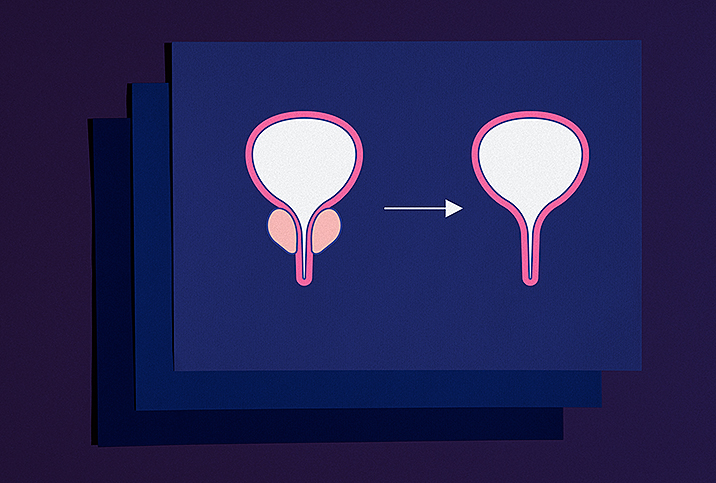Traction Devices Help Restore Penis Size After Prostatectomy

Prostate cancer is one of those looming concerns for most men that often doesn't get taken seriously until men find themselves approaching the typical at-risk age.
A more immediate concern for a lot of men is the size and shape of their penis—but the distance between prostate cancer and penile length isn't all that far. This is especially true for men who are diagnosed with an intermediate or high-risk form of the disease that necessitates surgical intervention to prevent significant consequences, such as the death of the patient or long-term effects resulting from metastatic disease.
Explaining radical prostatectomy and penile damage
"Radical prostatectomy, in general, is for patients who have prostate cancer," said Wael Almajed, M.D., a urologist and sexual medicine specialist at Tulane University in New Orleans. He further noted that prostatectomy is generally reserved for patients experiencing intermediate to high-risk iterations of the disease. This is because prostate cancer, in its higher risk capacity, has a dangerous chance of metastasizing, or spreading, creating a more serious risk to the life and well-being of the patient.
"By doing a radical prostatectomy when the disease is diagnosed, that can prevent future spread of the disease and it may improve quality of life in the long run and also the [chances of] survival from the disease," Almajed said. "Unfortunately, this treatment is quite radical because the nerves that go to and supply the penis run along the border of the prostate in what we call the neurovascular bundle."
Doctors typically try to spare these nerves, taking into consideration the lasting and potentially harmful effects the surgery can create for the patient. But if they're too reserved in the removal of tissue, they run the risk of unsuccessful treatment of the cancer, according to Almajed.
"To make sure that the cancer is completely taken out, sometimes these nerves get affected in the field of the resection of the prostate," he said.
This process is associated with multiple consequences for the penis, including erectile dysfunction (ED) and even a loss of penile length.
Enter penile traction devices
Men may wonder if the devices and medications designed to improve penis length or girth are legitimate or the stuff of myth. Discernible science shows that penile-lengthening traction devices can improve conditions for men who have experienced this particular downside of radical prostatectomy (and Peyronie's disease).
"It's a device that keeps the penis on traction for certain hours in the day, and patients can apply it for two months or so," Almajed said. "And that has shown that it can increase the length of the penis and the girth of the penis."
Amin Herati, M.D., a urologist and the director of male infertility and men's health at Johns Hopkins Medicine in Baltimore, has firsthand experience with patients using traction devices for penile lengthening.
"They're very happy," he said. "I have not met a patient yet who has not been satisfied with at least 1 to 2 centimeters of length gained."
A few different companies manufacture the devices, but one factor in their implementation is the out-of-pocket cost. Almajed said they often cost about $500, so some patients may not see the investment as worthwhile, especially when you consider that the devices, while often successful at adding length and girth, are not likely to create a dramatic difference in these aspects.
How often are penile traction devices used?
Penile traction devices don't necessarily have to be implemented in response to a major medical event or condition. They also have validity for health issues that encompass mental, physical and social aspects of body image or personal satisfaction.
"We use it in guys who have had prostatectomy and guys who have lost length due to Peyronie's disease," Herati said. "And just also in cases of body dysmorphia, where guys just want a little bit of a longer phallic length. The device does very well in that situation."
During prostatectomy recovery, men of different age ranges tend to have different focal points of interest as well as different expectations for the recovery process.
'I have not met a patient yet who has not been satisfied with at least 1 to 2 centimeters of length gained.'
"Patients who are younger tend to recover better and they tend to maintain their erectile function," Almajed said. "But as you go older [in patient age], we tend to see more erectile dysfunction experiences after the surgery. This could improve within the first year, but some people have persistent erectile dysfunction after the surgery."
Erectile function tends to take precedence over dysmorphic issues with many patients, so traction devices are not necessarily readily offered to all patients recovering from the radical intervention procedure for prostate cancer. Some men are happy to have or regain erectile function after a prostatectomy, and as such, they may not be concerned about a centimeter or two of lost penile length.
"In general, when we see patients in the clinic, they tend to present for erectile dysfunction," Almajed said. "If they come to our clinic and also express concerns that they lost a lot of their penile length and they want to seek options, then we offer them the penile traction device."
Men don't exactly receive a prescription, per se, from their doctors, but rather a recommendation when they voice concerns about loss of penile length. Men can order the devices online once they've received the doctor's recommendation, but again, the potentially high out-of-pocket cost may prevent some men from doing so.
Cancer considerations and more research
While it may be exciting to know that such penile recovery is possible, it's important to realize the drastic measures can largely be avoided through prudent cancer screening and treatment. Though health organizations' recommendations vary, men should start seriously considering prostate cancer screening around the age of 50 to 55, depending on a variety of factors. Genetic predispositions or familial history of cancer diagnoses may prompt your doctor to take extra precautions and recommend screening as early as age 40 or 45. This may also be true depending on personal history, lifestyle, work and recreational habits.
The important point to consider is that early detection of prostate cancer, or diagnosis of the disease in low-risk form, might mean nonsurgical intervention is possible as an effective means of treatment. Yes, such methods come with their own potential consequences, but early detection can help mitigate the need for radical prostatectomy, thus minimizing the risk of loss of penile length.


















